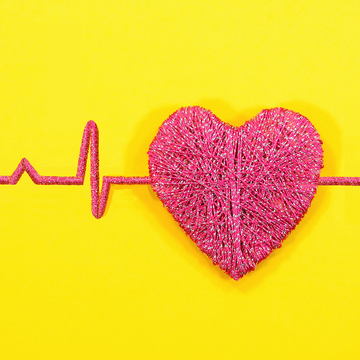Between the bleeding, cramping, moods, bloating, fatigue, you name it — getting your period is far from fun, no matter how long you’ve been dealing with it. So it’s no surprise that women are searching for anything to make getting through menstruation days just a little bit easier.
One of the trendiest topics right now is cycle syncing workouts, a buzzy term used to explain specific types of exercises that are best done at certain times of your menstrual cycle (fun fact: it actually consists of four phases, not just the one where you bleed).
But what exactly does cycle syncing workouts mean, how do you put it into practice and does it even really make a difference? We went straight to the experts to find out.
What is cycle syncing?
It’s pretty much exactly what it sounds like: You choose which type of workout to do that day or week based on which phase of your hormonal cycle you’re in. “Cycle syncing is honoring how your body and mind are feeling in each phase of your menstrual cycle. Aligning your workouts, nutrition and daily habits to those phases allows you to maximize your potential and stay consistent in your routine throughout the month — rather than fighting your body for wanting to follow its natural rhythms,” explains Micaela Garcia-Baab, NASM-CPT, lead performance coach at digital fitness coaching service Future.
The thought is that exercising according to your hormonal phases (menstrual, follicular, ovulation, luteal) will help you be more efficient when it comes to meeting fitness goals — plus make you likelier to actually get a workout in on those extra blah days.
The benefits of cycle syncing
There’s anecdotal evidence that cycle syncing has body benefits, and some of those potential benefits may be more “felt,” rather than seen on blood work. “Several of my clients have remarked that cycle syncing completely changed their relationship with exercise — instead of feeling like a punishment or obligation, exercise is now a valued part of their daily routine and a celebration of what their body can do during difference hormonal phases,” Garcia-Baab says.
While this method might not yet have conclusive research to say, “yes, this is the best way for women to exercise,” the concept makes sense and science is beginning to move the needle toward an answer.
“Concentrations of sex hormones do change and fluctuate across the menstrual cycle and this may have an impact on exercise performance; however, there is no substantial evidence on exactly how this impacts the workouts done in accordance with a phase in the menstrual cycle,” says Jessica Shepherd, M.D., an ob-gyn, women’s health expert, and founder of Sanctum Wellness in Dallas, Texas. “Happily, there are more studies being devoted to this, and this will hopefully shed light on changes needed to adjust workouts appropriately."
Still, the benefits of getting regular physical activity at all times of the month are well-documented by research, and we think worth the effort:
- Longer lifespan
- Lower risk of heart disease, heart attack, stroke, type 2 diabetes and some cancers
- Promotes healthy blood pressure, cholesterol, circulation, healthy weight maintenance
- Supports cognitive function and reduces risk for brain diseases like Alzheimer’s
- Stabilizes blood sugar levels
- Supports hormonal regulation and production
- Helps maintain muscle mass and bone density
- Plays a role in mood regulation, stress reduction and reducing anxiety and depression
- Aids in balance and coordination
- Supports healthy lifestyle habits such as getting good quality sleep
Cycle syncing workouts and tips
Thoroughly curious? Follow this guide to give cycle syncing a try.
Match your workouts to each phase
“At each hormonal phase you will experience varying levels of energy, strength and endurance. Aligning your fitness routine with your cycle allows you to do daily check ins, and understand when you should push yourself and when to give yourself a day to recover,” Garcia-Baab explains. Nobody’s cycle is exactly the same, but using a calendar or smartphone app to track may help you guess when you’re in each phase.
Tweak the rest of your daily routine
If you’re letting your hormones guide the way when it comes to working out, do the same in other good-for-you areas of your lifestyle. For instance, during phases when you don’t have as much energy, it’s important to eat enough and focus on foods that support steady energy (such as a combo of carbs, protein, and healthy fat); this is also when you’ll want to prioritize getting enough quality sleep.
When you’re in a phase that dictates a more intense workout routine, fueling up before and after exercise is crucial to maximize your efforts. Focus on protein, as well as “complex carbs like fruit, whole grains, and starchy vegetables, which will help support all of your adventures,” says Garcia-Baab.
And, “the menstrual phase is a fabulous time to really think intuitively and engage in emotional processing, and I go deeper in therapeutic work during my luteal phase,” says Kirat Randhawa, a meditation expert with Alo Moves.
Don’t forget to hydrate
Staying hydrated should be top of mind 24/7/365, and that includes during each phase of your cycle. Our body as a whole needs proper hydration to function at its best, and sometimes certain body processes (such as a slight increase in body temp during ovulation) can impact fluid levels. Try to make it a habit to slug water before, during, and after exercise. Pad your H20 intake by loading up on plenty of fruits and vegetables, which have a high water content. And consider starting each day by downing a glass of water before you even get out of bed.
Bottom line: Even though matching your workouts to your hormonal phases is meant to maximize your capabilities during that period of time, we’re all still human, so don’t beat yourself up if you can’t stick to the plan sometimes. “I truly think listening to your body is best. Tune in during each day and honestly ask yourself what your capacity is. Being attuned to the body allows us to be creative, flexible and understanding — so if you sometimes have to shorten a workout so as not to tax yourself, that’s OK,” Randhawa says. On those days when you feel done before you’ve even begun, abide by the 10-minute rule: “Give the workout 10 minutes, and if at the end of that time you still want to wrap it up and go home, then you should! You can always try again another day,” says Garcia-Baab.
Stefani (she/her) is a registered dietitian, a NASM-certified personal trainer and the director of the Good Housekeeping Institute Nutrition and Fitness Lab, where she oversees all nutrition and fitness-related content, testing and evaluation. She holds a master’s degree in clinical nutrition from New York University, as well as advanced certifications as a Women's Fitness Specialist and a Behavior Change Specialist. Stefani is dedicated to providing readers with evidence-based content to encourage informed food choices and healthy living. She is an avid CrossFitter and a passionate home cook who loves spending time with her big fit Greek family.













